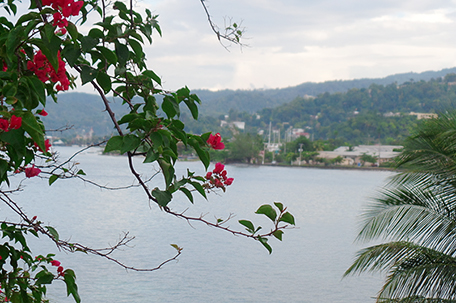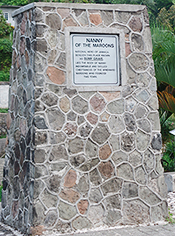
ABOVE PHOTO: Port Antonio
By Renée S. Gordon
“If we must die, let it not be like hogs,
Hunted and penned in an inglorious spot,
While round us bark the mad and hungry dogs,
Making their mock at our accursèd lot.”
–Claude McKay*
Three of the most important anchors of Jamaica’s culture and heritage are the richness of the language, the cuisine and the music. These unique aspects of the island’s traditions will be a focus of our sojourn as we continue in Kingston and then travel to Port Antonio for experiences that take us deeper into the island’s legacy.
Colorful speech is found throughout the island and even though English is the official language Jamaican Patois, or Creole, is heard everywhere. It is this combination of English and African that resulted from the need for the English to communicate with the enslaved and for communication with each other. Many of the words migrated into the language when there was an African designation and the slaves either preferred to use it or there was no comparable word. In the 1950s the Rastafarians introduced their own linguistic variations based largely on their belief system as well as creating new words and reggae music uses this language, symbolism and philosophy to both entertain and promote social awareness.
The same year Columbus anchored in Jamaica he brought sugarcane cuttings from the Canary Islands and set into motion a series of events that would impact the world economy forever. By the 1600s molasses, a residue of the boiling of the sugar cane to create sugar, the most important Caribbean product, had become a problem. A pound of molasses was leftover from two pounds of sugar and some planters turned to dumping it in the sea because so much was left. It is believed that around 1620 on Barbados they began to use the residual molasses to make alcohol.
Rum’s first documented mention dates from 1652 when rumbullion is referred to as kill-devil, a distilled molasses drink. The general consensus is that rum is an abbreviation of the English word “rumbullion” meaning a big commotion and within two years nearly 1 million gallons were made yearly in the Caribbean. It would become an important trade item, often used in lieu of hard currency, and a crucial factor in the third leg of the Triangle trade. In the 1800s, Jamaica became the leading rum distiller with 148 distilleries in 1893. Today, Jamaica’s six distilleries produce the greatest number of varieties of rum internationally and by 2016 Jamaican rum will have attained the prestigious GI certification indicating that its quality and characteristics are directly attributed to its place of origin.
Nassau Valley’s Appleton Estate was first cited as a rum-producing estate in 1749, 106-years after the Appleton Estate was granted to the Dickson family. The geographical features of the valley, spring water, limestone hills, climate and the fact that Appleton controls the process from the “cane to the cup” have made the Jamaican Appleton Rums famous. In 1845, a non-family member purchased the estate and in 1916 J. Wray and Nephew Ltd. became the owners.
Joy Spence was appointed the Master Blender in 1997, the first female in the spirits industry to attain this position worldwide. She received a Bachelor of Science Degree with First Class Honors, a Master of Science degree with Honors and the highest final exam scores ever achieved by any student at her university.
Tours of the Appleton Estate in Nassau Valley are offered as well as Spirits training at the JWN Academy in Kingston. The Kingston Academy offers blending classes by pre-arrangement that include a film and comprehensive information on Appleton Rum qualities and production. [email protected]
You have not eaten in Kingston if you have not dined at Scotchies Tree New Kingston, a true Jamaican experience. Diners eat in thatch-roofed gazebos set in an outdoor garden surrounded by lush foliage and exotic flowers. Scotchies’ menu reads like a list of all of the dishes that are unique to Jamaica and Caribbean culture and visitors have the opportunity to watch the food being cooked on a traditional wood-smoking grill. The restaurant is most famous for its delicious jerk chicken and pork. Historically West African Coromantee hunters roasted wild pigs in pits using a blend of seasonings and spices that were unique and largely kept secret. Later Maroon communities commonly used this method of cooking. Other favorites served here are steamed fish, roasted breadfruit and the national dish, ackee and salt fish. The ackee is the fruit from a West African tree, “Akye Fufo”, brought to Jamaica in the 1700s.
The next stop on our cultural and heritage tour is Portland Parish, approximately 60-miles from Kingston on the northeastern coast of the island. It is far less urban than most of the other parishes and allows visitors to experience Jamaica’s raw beauty from the 7,402-ft. Blue Mountains down to the shores of the sea. The capital city, Port Antonio, was established in the 1680s but the parish dates from 1723.
Jamaica’s first inscribed UNESCO World Heritage Site was the Blue and Jim Crow Mountains. They cover 33 percent of the island and are home to 200 bird and 500 plant species and are increasingly renowned for the famous Blue Mountain Coffee. Views of the mountains are terrific as you pass along the road. bluemountaincoffee.com
You know you are in Portland when you reach Dickie’s Best Kept Secret, a restaurant cut into and built along side the cliffs. Owner Dickie Butler built it by hand and crafted most of the furnishings. The restaurant has several levels and a set of steps that lead to the beach. An experienced chef, Butler cooks all the food and reservations are mandatory. The food is so fresh that when making your reservation if you specify fish they go out and catch it. Dinner here is a bucket list experience.
Port Antonio is credited with being the “Birthplace of Jamaican Tourism”, an outgrowth of its once being the “Banana Capital of the World”. It was a shipping port for bananas and the inspiration for “Day-O”, or “The Banana Boat Song” and it is said that tourists hitched a ride here on the banana boats arriving from the US. portantoniojamaica.com
American film star Erroll Flynn gets some of the credit for increasing the region’s popularity when in 1942 he was forced by a storm to anchor his yacht on the island. He traveled to Port Antonio by motorcycle and was captivated by its unspoiled beauty. He moved here permanently in 1950 and the rich and famous flocked to the area.
Rio Grande River Rafting as recreation, introduced by Flynn, is a tourist magnet. Rafting tours are approximately two hours long and are poled by raft captains. Originally, the bamboo rafts were used to carry bananas from the interior to the seaport. Visitors are transported through stunning scenery on 30-ft. long rafts that seat two. Elizabeth Taylor and Richard Burton were known to spend the entire day rafting the river valley using four rafts, one for them, one for food, one with a bar and one with musicians. Feel free to duplicate the experience. explorejamaica.com.jm/rio-grande-rafting-jamaica
Trident Castle, in Turtle Crawl Bay, is the sole castle in the entire Caribbean. The Austrian Baroque structure was built in the 1980s for a German Baroness, but ownership subsequently passed to the Levy family. It can be rented and the list of international celebrities who arrive on the property via helicopter for a secluded villa vacation inspires awe. The castle is as photogenic as it is legendary. castleportantonio.com
Jon Baker of Gee Street Records founded GeeJam Recording Studio in Port Antonio in 2000. Tours of the state-of-the art studio, designed to provide the complete production process, can be arranged. Recording took place at all hours and performers began staying in bungalows on the property and today Geejam Hotel is a much-awarded luxury boutique resort. This is one for the glitterati but specials are available online. geejamhotel.com
The Bush Bar is part of the Geejam complex. Dining there is like dining in an elegant treehouse overlooking the sea and lush foliage, with Jamaican-Asian gourmet cuisine and entertainment. The house band is the internationally famous Jamaican Mento musicians, the Jolly Boys. They have been performing since the 1950s, when they began as the Navy Island Swamp Boys. They recently released their album “Great Expectations.” geejamhotel.com/bushbar
Mento is a distinctive Jamaican folk music that is rooted in the music created by the slaves combined with European forms. It traditionally features acoustic instruments the most unique of which is the bass rhumba box that the musician sits on while playing. Mento was first recorded in the 50s and is a precursor of ska and reggae.
The Blue and Jim Crow Mountains were designated a UNESCO site based partially on their place in cultural history as an area of sanctuary and sustenance to the Maroons fleeing colonial rule and slavery. The indigenous Taino Indians were the first to seek refuge in the mountains, followed by slaves. “Maroon” is derived from the Spanish word cimarron meaning “wild”, used to describe those who fled and fought back.
When the English conquered the island in 1645, they commanded the Spanish to surrender all their goods, including their slaves, and vacate the island. Some Spanish and many of the slaves fled into the hills and waged a guerilla campaign. The Spanish formally turned Jamaica over to the British in 1655 and the island became a lucrative slave-trading center. Although money was generated from the trade, the enslaved and Maroons exacted a cost. Between 1680-1785, more than 600,000 slaves were imported, there were 16 slave rebellions before 1813, uprisings in 1816, 1823 and 1832 and by the 1820s more than 2,500 runaways were documented annually. The Maroons, refusing reenslavement, became a well-trained, organized fighting force and because of their location in the hills they could strike any plantation and their mountain fortress was difficult to attack.
Nanny of the Maroons, a warrior, leader and priestess, now one of Jamaica’s National Heroes, was enslaved on the islands. It is believed she was a member of the Ashanti Tribe from Ghana and she was brought to Jamaica in the late 1680s. By 1720, she and her brothers had escaped and she had established a settlement in the mountains. Once there, the Maroons established an Afrocentric community that maintained traditional African customs and values. After numerous attempts to overcome the settlement the British signed a treaty with Nanny’s brother over her objections and Nanny and her followers moved to another site and established New Nanny Town in 1739.
New Nanny Town was closely guarded and once anyone crossed the Black Rio Grande River they were watched. If they reached Watches Hill an abeng, a cow horn blown from the side that can be heard over 10-miles away, was used to sound a warning. The abeng functioned as a war horn and method of communication. It continues to be played at festivals, funerals and community assemblies. The name comes from the Akan word for horn.
New Nanny Town, now Moore Town, is 11-miles from Port Antonio and continues to be inhabited by descendants of the original Maroons. A colonel and a 24-member council govern the town. The current colonel, Wallace Sterling, has served voluntarily for over 20 years. Guided tours of New Nanny Town can be arranged or visitors can embark on a self-guided tour. The Cultural Center should be the first stop for information, to view a small display of artifacts and to purchase crafts. Guided tours offer an opportunity to see a call and response music and dance performance specific to Moore Town Maroons. Two drums, Kromanti, are anointed with rum, as both a gift to the gods and to lubricate the skins. One drum plays the rhythm and the other is used for improvisational beats. The drums and songs are more than 250-years old.
The highlight of a visit to Moore Town is a stop at the Bump Grave, where Nanny is interred. A stone monument has been erected, inscribed and placed on a stone patio with an inset of an abeng imbedded in the ground. mooretown.weebly.com
Goblin Hill Villas is situated on picturesque San San Bay in Port Antonio and offers 12-acres of accommodations, beaches, tennis courts, a pool and exotic flora and fauna. Villas are fully furnished and are staffed with a housekeeper who, in addition to general housekeeping duties, will prepare meals. The panoramic views here are stunning and Goblin Hill has been listed as being “the best place to watch the sunset”. goblinhill.com
Club Kingston at the Norman Manley International Airport gives visitors a chance to extend their trip just a little more. For a fee guests can avail themselves of departure services including open bar, bountiful buffet, business services, video games, shower facilities and special boarding privileges. Noted Jamaican artists’ works decorate the Club and a variety of reading materials are offered. This is a particularly good choice if you have a long wait for your flight. vipattractions.com/club-kingston.php
Now is the time to start planning your visit; www.visitjamaica.com
I wish you smooth travels!
*Ironically, Winston Churchill quoted McKay’s poem in the British House of Commons to rally support against Germany.


















Leave a Comment